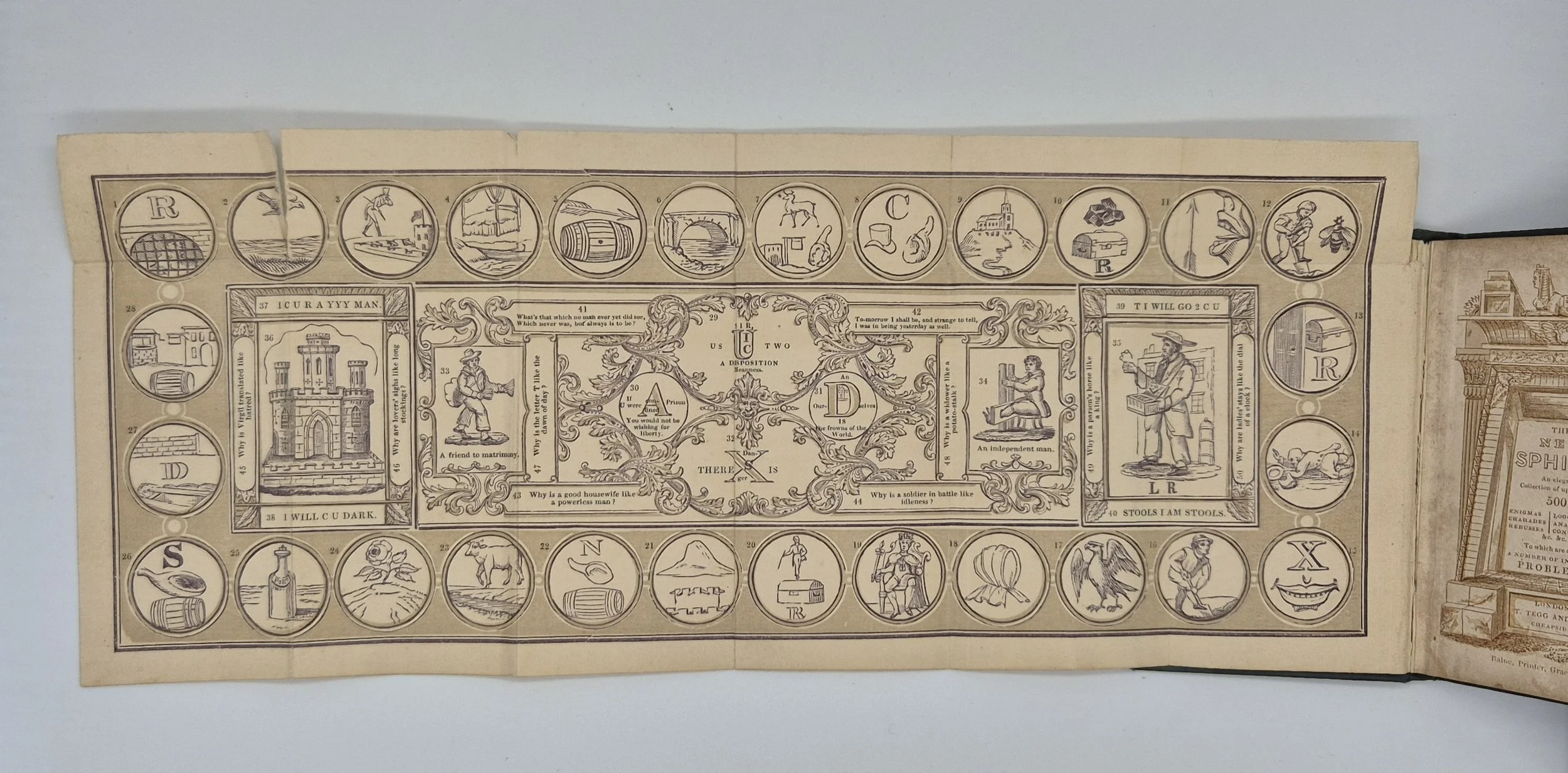 Image 1 of 2
Image 1 of 2

 Image 2 of 2
Image 2 of 2



The New Sphinx. An Elegant Collection of 500 Enigmas, Charades, Rebusses, Logoriphes, Anagrams, Conundrums &c. &c. To which are added a number of ingenious problems.
[RIDDLES]
The New Sphinx. An Elegant Collection of 500 Enigmas, Charades, Rebusses, Logoriphes, Anagrams, Conundrums &c. &c. To which are added a number of ingenious problems.
London: T. Tegg and Son, [c. 1832]
16mo., publisher’s green ribbed cloth, decorative title piece in gilt to centre of upper board; with single-ruled border and cornerpieces in blind to both covers; spine fully decorated in gilt; a.e.g.; pp. [iii], 2-144, with decorative title page printed in brown, folding ‘enigmatical’ frontis plate; and several further illustrations in line to the ‘Problems’ pages from p. 130-144; cloth a little bubbled and dulled, with a couple of light stains and bumps to corners/spine tips; early sticker from the White & Sons circulating library, Carmarthen to the front paste-down; 3cm closed tear to the upper edge of folding plate; a little cracked to gutters, but holding firm; title page a touch toned. An excellent survival of a scarce work.
First edition, in the original publisher’s cloth, of this entertaining little book. Packed full of 507 games and puzzles, the chapters are divided into Enigmas, Charades, Rebusses, Anagrams, Conundrums, and the all-important solutions, followed by a series of practical problems which require physical objects, for example ‘making a shilling turn upon its edge on the point of a needle’ and ‘the turn-wonder’, which involves lifting a bottle using only a straw. Page 120 gives an explanation of the frontispiece, which includes the names of members of the nobility included in the Rebus puzzles (number one, for example, showing the letter ‘R’ above a lion in a cage below, translating to ‘Arden’).
A wonderful collection of parlour puzzles and entertainments, likely intended for evening entertainment in a Regency home. The book was preceded by ‘The sphinx; or, Agreeable Companion for a winter's evening…’, an extremely popular work which was first published in the early 1820s.
Scarce. Only two copies of this edition recorded in COPAC, at the BL and Yale.
[RIDDLES]
The New Sphinx. An Elegant Collection of 500 Enigmas, Charades, Rebusses, Logoriphes, Anagrams, Conundrums &c. &c. To which are added a number of ingenious problems.
London: T. Tegg and Son, [c. 1832]
16mo., publisher’s green ribbed cloth, decorative title piece in gilt to centre of upper board; with single-ruled border and cornerpieces in blind to both covers; spine fully decorated in gilt; a.e.g.; pp. [iii], 2-144, with decorative title page printed in brown, folding ‘enigmatical’ frontis plate; and several further illustrations in line to the ‘Problems’ pages from p. 130-144; cloth a little bubbled and dulled, with a couple of light stains and bumps to corners/spine tips; early sticker from the White & Sons circulating library, Carmarthen to the front paste-down; 3cm closed tear to the upper edge of folding plate; a little cracked to gutters, but holding firm; title page a touch toned. An excellent survival of a scarce work.
First edition, in the original publisher’s cloth, of this entertaining little book. Packed full of 507 games and puzzles, the chapters are divided into Enigmas, Charades, Rebusses, Anagrams, Conundrums, and the all-important solutions, followed by a series of practical problems which require physical objects, for example ‘making a shilling turn upon its edge on the point of a needle’ and ‘the turn-wonder’, which involves lifting a bottle using only a straw. Page 120 gives an explanation of the frontispiece, which includes the names of members of the nobility included in the Rebus puzzles (number one, for example, showing the letter ‘R’ above a lion in a cage below, translating to ‘Arden’).
A wonderful collection of parlour puzzles and entertainments, likely intended for evening entertainment in a Regency home. The book was preceded by ‘The sphinx; or, Agreeable Companion for a winter's evening…’, an extremely popular work which was first published in the early 1820s.
Scarce. Only two copies of this edition recorded in COPAC, at the BL and Yale.

